Easy Roasted Thanksgiving Turkey
on Nov 16, 2020, Updated Sep 26, 2024
This post may contain affiliate links. Please read our disclosure policy.
All you need to know to get a perfectly roasted moist and tender turkey on the table.
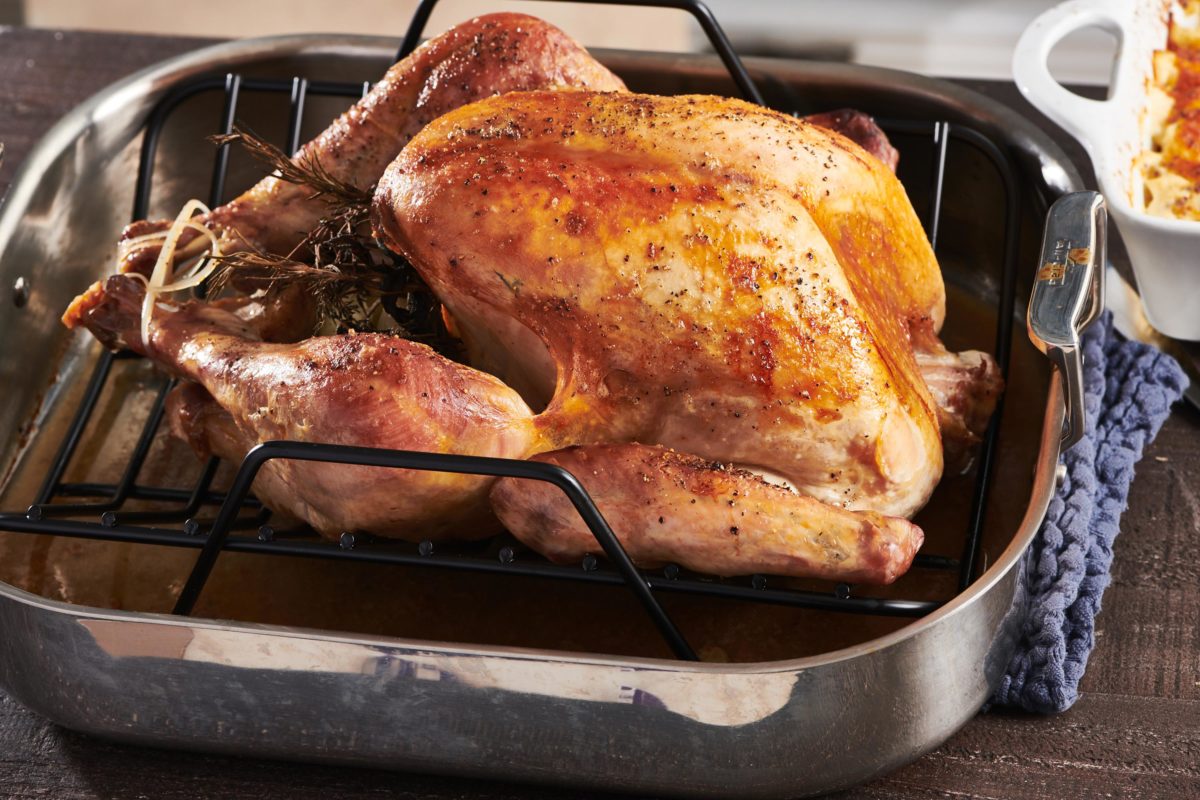
Some people like to play around with their holiday menus. I certainly do — but not at Thanksgiving! That is the turkey holiday; no ifs and’s or buts about it. The side dish might change a little from year to year, but there will always be a traditional roasted turkey on the table in my house. This simple roast turkey recipe is just the classic; nothing fancy or trendy about it. And absolutely think about making Make-Ahead Turkey Gravy — my family would revolt if I served turkey with no gravy!
Then go right ahead and explore those sides! Think about Sweet Potato Casserole with Marshmallows, Traditional Thanksgiving Stuffing, Sweet Cranberry Sauce, and the best Parmesan Roasted Brussels Sprouts.
By signing up, you agree to our Privacy Policy.
What's In This Post?
- Thanksgiving Turkey Tips
- What Size Turkey Should I Buy For Thanksgiving?
- Ingredients
- How to Dry Brine a Thanksgiving Turkey
- Thanksgiving Turkey Cooking Times
- How to Make Simple Roasted Thanksgiving Turkey
- FAQs
- Tips for Safely Cooking a Turkey
- Leftover Roast Turkey
- What to Serve With Thanksgiving Turkey
- More Thanksgiving Turkey Recipes
- Easy Roasted Thanksgiving Turkey Recipe
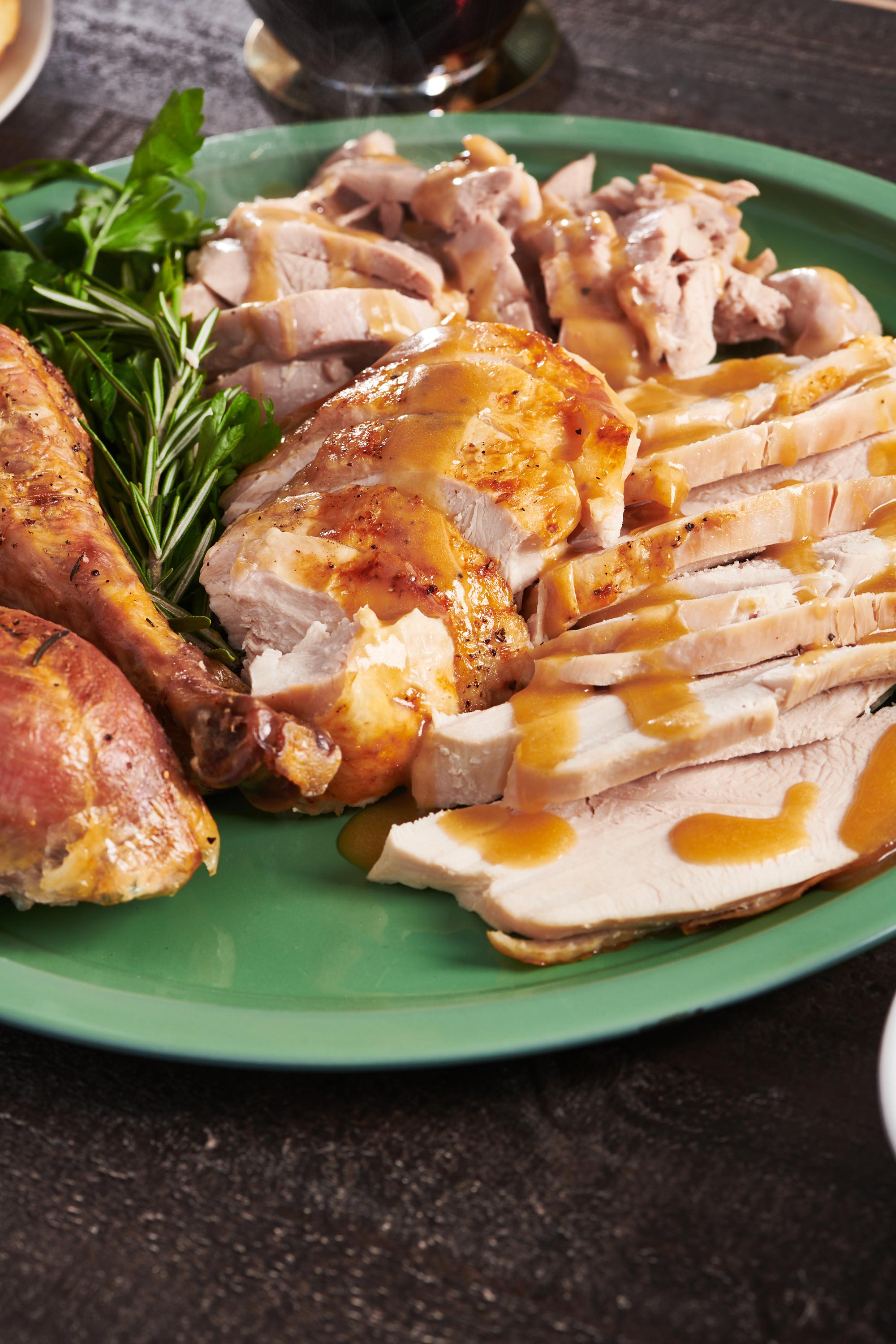
Thanksgiving Turkey Tips
Whether you are cooking your very first traditional Thanksgiving turkey or your 50th, it’s always good to have a refresher (or a primer) on turkey roasting best practices. And if you are looking for an easy recipe for a whole turkey, you’ve landed in a good place!
You can also explore recipes for turkey breasts, should you want to head in that direction. Also, if you’re looking to spice it up a bit this year with a less traditional turkey, why not try a Cajun Roasted Turkey?
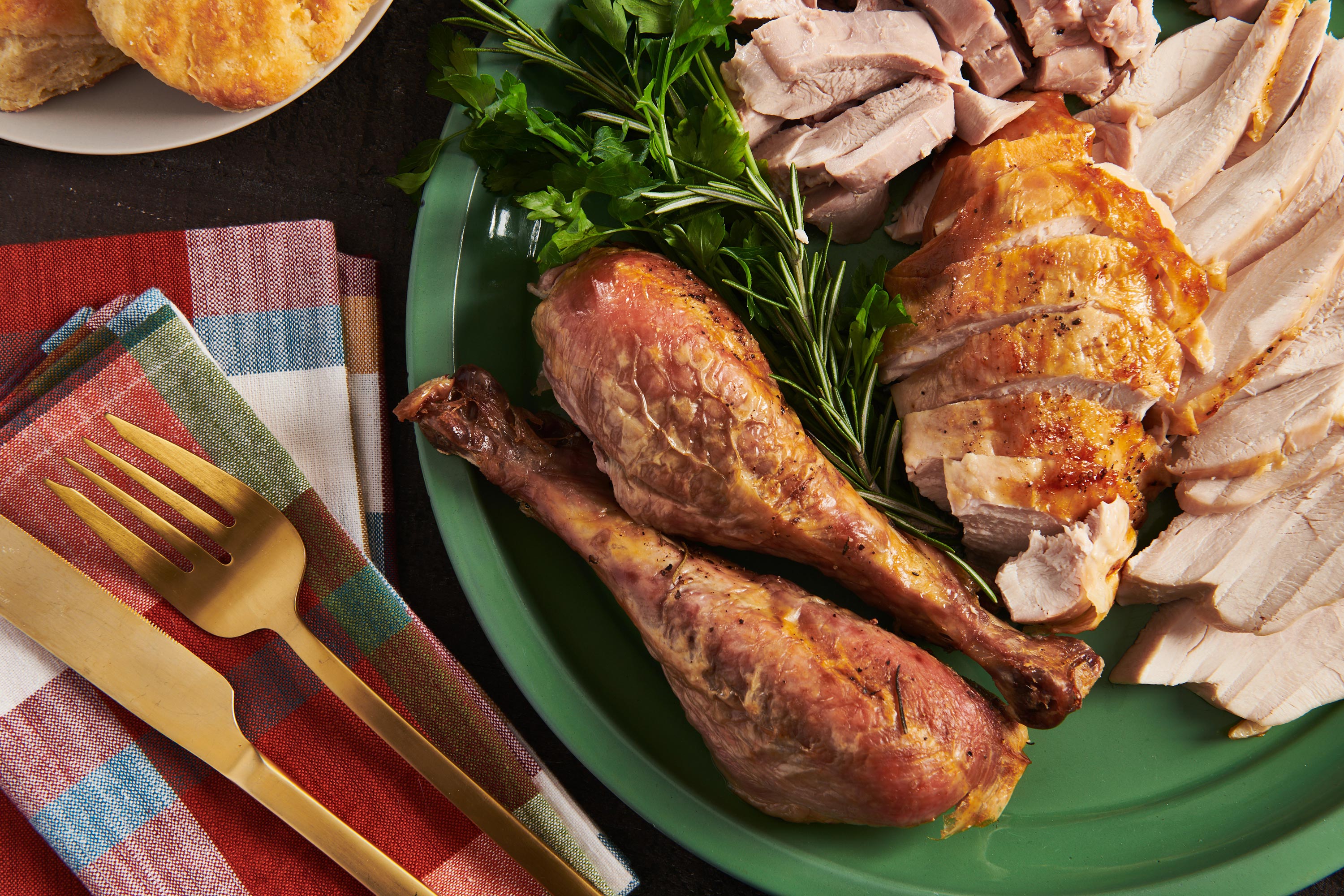
What Size Turkey Should I Buy For Thanksgiving?
Most birds sold for Thanksgiving dinners in U.S. supermarkets are in the 16-pound range, though some are much larger. That size turkey will serve 12 to 16 people. As a general rule, when buying a turkey, aim for about 1 pound per person when purchasing a whole bird. When cooking a smaller bird, especially if you want leftovers, go for a bird that equates to about 1 ½ pounds per person.
All things considered, a 12-pound turkey is not too large for a group of 8. It will feed your gang generously and allow for leftovers, which are the perfect springboard for sandwiches and all kinds of turkey recipes later in the week.
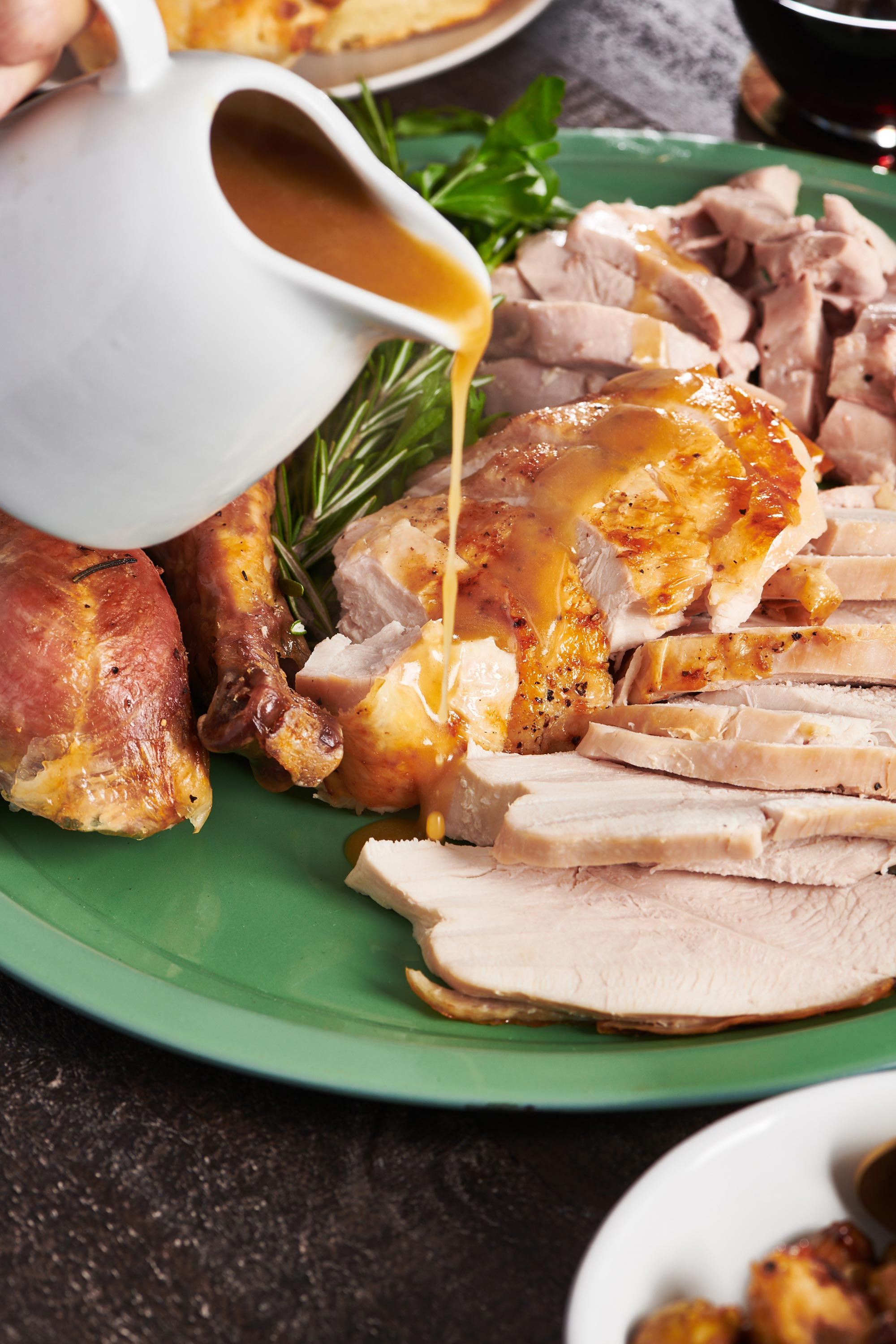
Ingredients
- Turkey – Either a fresh turkey or a frozen turkey will work, but if your turkey is frozen, make sure to defrost it all the way before roasting. Be sure to brush up on tips for safely defrosting a frozen turkey!
- Unsalted butter – Part of the butter is used to coat the turkey during the brining stage, and the rest is slathered on right before roasting.
- Kosher salt – Salt does more than season the turkey. When used in a dry brine, it permeates right to the center of the turkey to bring out its flavor and tenderize the meat so that it cooks up juicy and flavorful.
- Orange – Gets tucked inside the bird to help provide a bit of sweet acidity and flavor the juices for the gravy.
- Yellow onions – Just like the orange, these get placed inside the turkey while it roasts, adding flavor.
- Rosemary and Thyme – Fresh rosemary and fresh thyme infuse the bird with a lovely woodsy, herby flavor.
- Black pepper – Use freshly ground black pepper for the best flavor.
- White wine – Adds acidity and depth to the juices that develop in the bottom of the pan while roasting and then gets used to make gravy.
- Chicken broth – Gets poured into the bottom of the pan to blend into the delicious drippings that result from the roasting process.
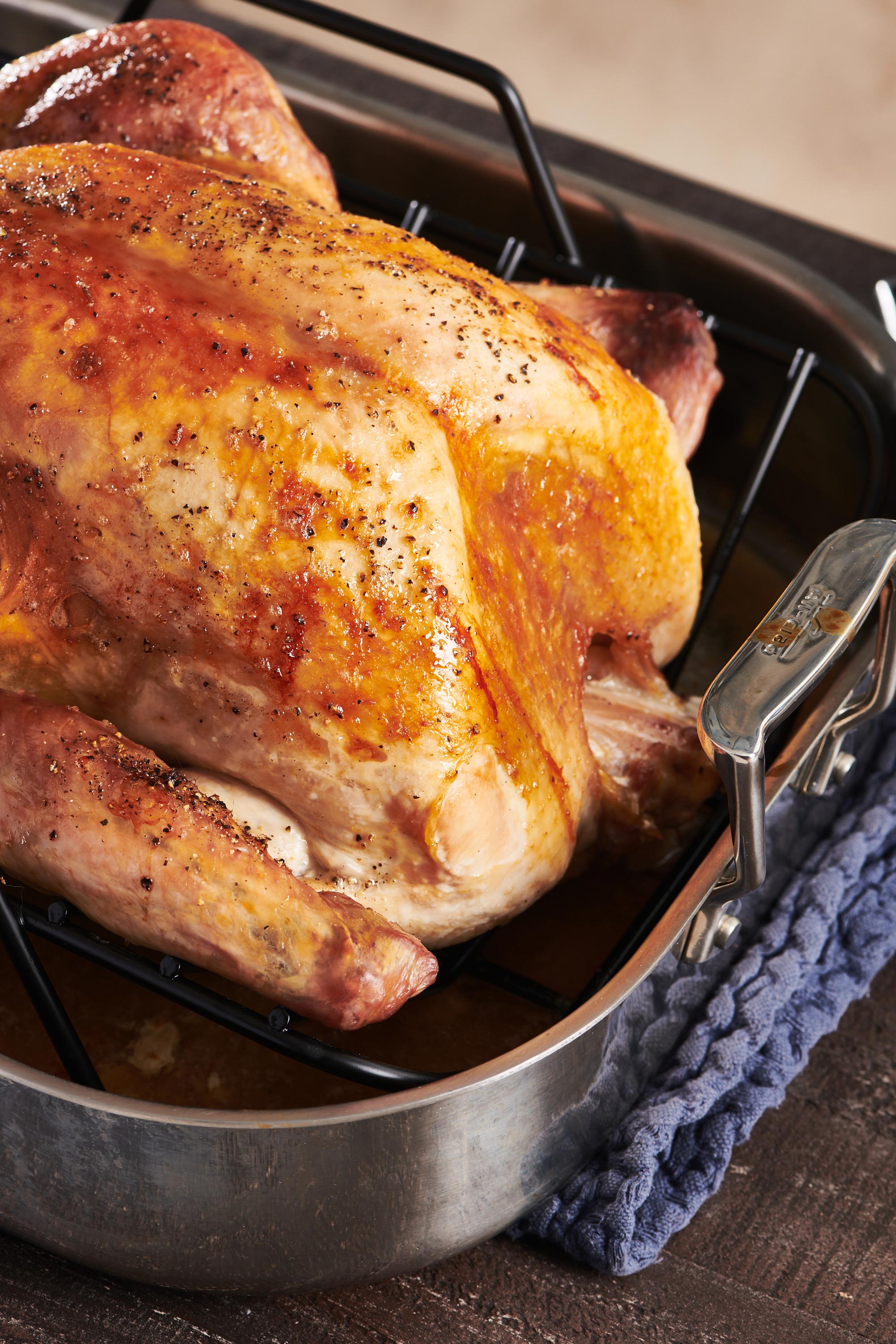
How to Dry Brine a Thanksgiving Turkey
Brining the turkey results in meat that is moist and flavorful — all of those complaints about dry breast meat will be but a distant memory once you master this simple technique. Dry brining is great because it doesn’t require more space in the fridge than the turkey itself and doesn’t require constantly changing ice in a big ice bath. If you want to try a wet brine recipe, it will work for a whole turkey or just the breast.
If you do not have the time or space to dry brine the turkey, do not worry. Brining ensures the meat will be extra moist and tender, but you can absolutely get to a delicious Thanksgiving turkey without brining. Just pay close attention to the cooking time and the internal temperature, and you’ll be good to go.
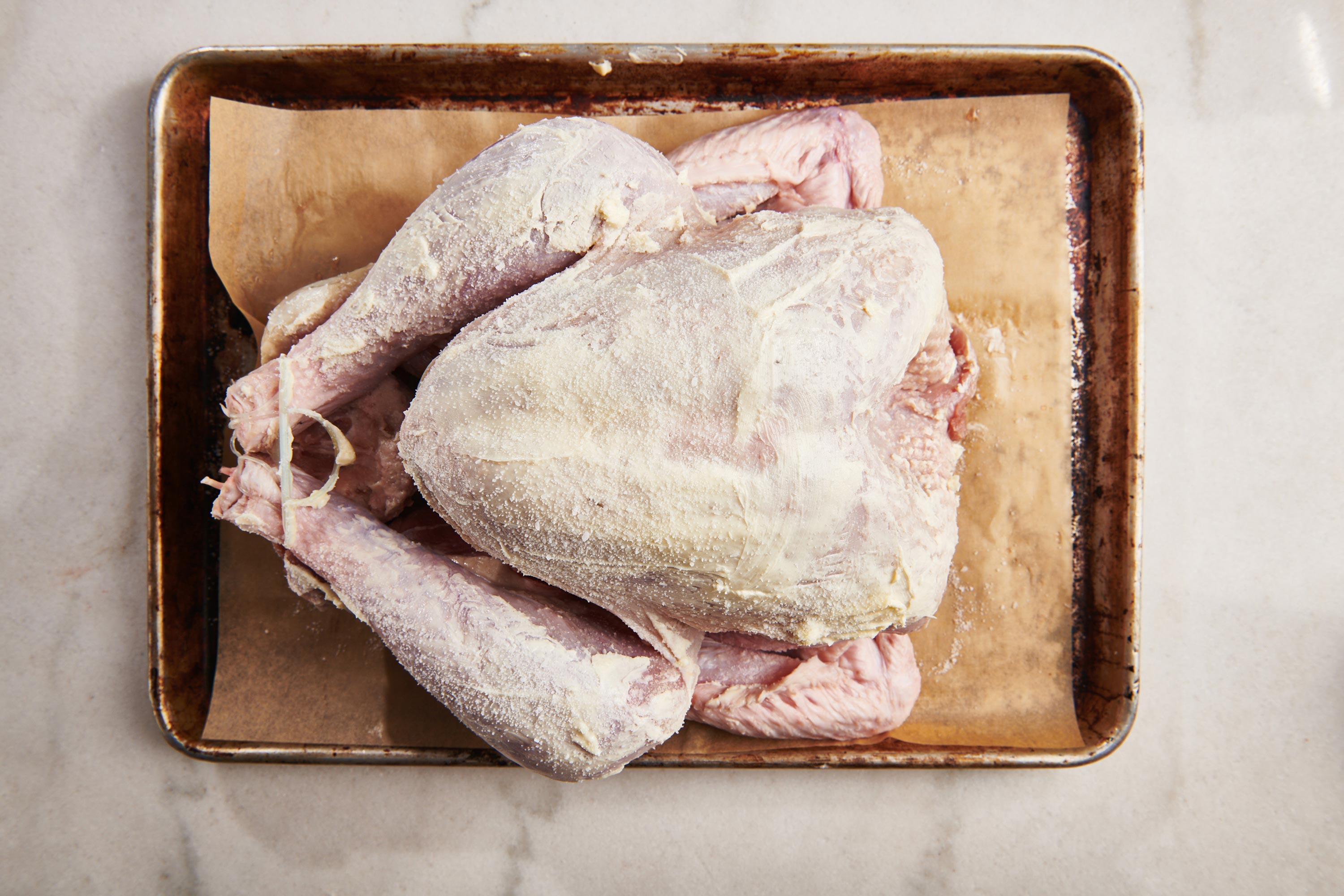
To dry brine a turkey, you must use kosher salt — regular table salt will result in a bird that is way too salty and also result in a bird that is mushy in texture.
Thanksgiving Turkey Cooking Times
The following times are for a turkey roasted at a continuous 325-degree temperature. The USDA does not recommend cooking a turkey at a lower temperature than 325 degrees to prevent food-borne illness. These are the times recommended by the USDA.
You should find the lowest cooking time for your size bird and start checking the internal temperature about 45 minutes ahead of that suggested time. Don’t rely completely on the pop-up timer; the turkey may have reached the desired temperature before it pops up. For more information, see How Long to Cook a Turkey.
| Turkey Weight | Cook Time (Unstuffed) | Cook Time (Stuffed) |
|---|---|---|
| 8 to 12 pounds | 2 ¾ to 3 hours | 3 to 3 ½ hours |
| 12 to 14 pounds | 3 to ¾ hours | 3 ½ to 4 hours stuffed |
| 14 to 18 pounds | 3 ¾ to 4 ¼ hours | 4 to 4 ¼ hours |
| 20 to 24 pounds | 4 ½ to 5 hours | 4 ¾ to 5 ¼ hours |
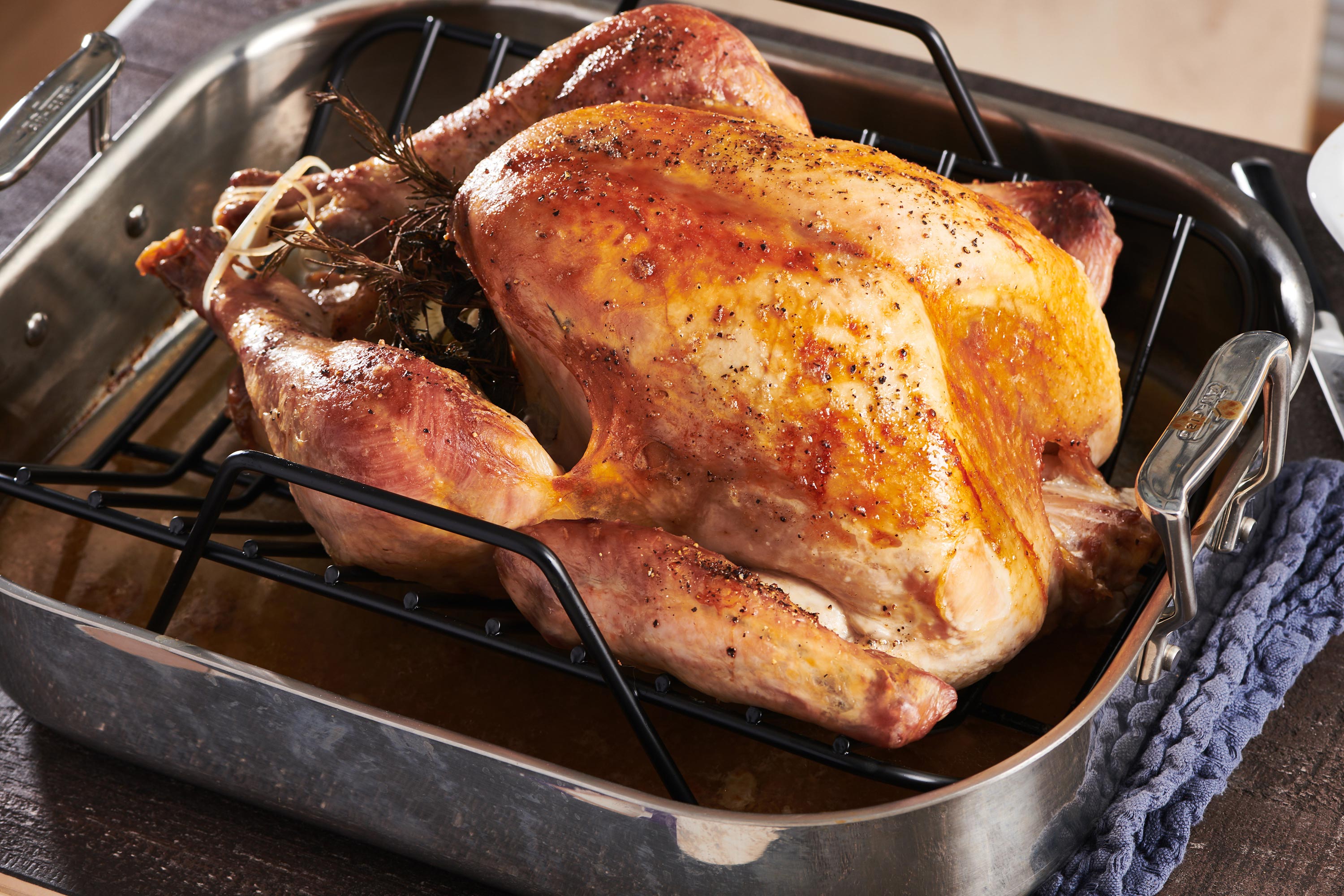
How to Make Simple Roasted Thanksgiving Turkey
- Brine the turkey: Dry your turkey off and rub softened butter all over it. Then cover every surface with the salt, inside and out — don’t be shy, it needs a lot of salt! Seal the turkey in a plastic bag and let it rest in the fridge for 2 or 3 days. When you get a chance, turn the turkey to help it brine evenly.
- Dry the turkey: After 2 to 3 days of brining, the turkey is ready to be dried. This should happen the day before Thanksgiving. Simply remove the bird from its bag, pat it dry, and refrigerate uncovered until the next day.
- Prepare to roast: Remove the turkey from the fridge to bring it to room temperature. Meanwhile, preheat the oven to 325 degrees.
- Stuff the turkey: Fill the inside cavity of the bird with the orange, onions, rosemary, and thyme. Place it on a roasting pan and tuck the wings under the body, then tie the legs together to the cavity is closed.
- Season: Rub softened butter all over the turkey’s skin. This will help it get golden and crispy in the oven. Season the whole turkey with pepper. Place it in the oven, and with the oven still open, pour the wine and chicken broth into the bottom of the roasting pan.
- Baste and check temperature: After 1 hour of roasting, baste the bird with its juices from the pan. After 2 hours, start checking the turkey’s internal temperature. Just keep checking until the turkey reaches 160 degrees. There is also more information on turkey cooking time here.
- Rest: When the turkey reaches 160 degrees, take it out of the oven and rest it. Tent the bird loosely with foil and let it sit for at least 20 minutes.
- Remove the fat: Pour all of the pan juices into a container and place it in the fridge. The fat will separate and rise to the top, becoming solid. Then, you can simply scrape off the fat layer with a spoon. Now, your juices are ready to be made into gravy.
- Carve & serve: Get essential tips for the best way to carve a turkey. You will remove the wings and legs, separate the thigh from the drumstick, and then slice the thighs. Then, remove the breasts and slice them.
FAQs
The basic rule of thumb is to cook a turkey for 20 minutes per pound. A larger bird may take slightly less time per pound to cook, whereas a smaller bird might take more. See the chart above for more detailed information.
The USDA doesn’t recommend rinsing the turkey because it can spread bacteria in your sink and in your kitchen. By the time the turkey is cooked to a safe temperature, any bacteria should be killed.
The safe internal temperature for a roasted turkey is 165 degrees. Insert your meat thermometer into the thickest part of the thigh, but make sure it doesn’t touch the bone, which can result in a false temperature reading. Also, check the thickest part of the breast, not touching the bone.
The internal temperature of the turkey will rise once it is taken from the oven, as it rests (which it needs to do to reincorporate the juices as well). So, if you take your turkey from the oven when the temperature reads 160 degrees when the meat thermometer is inserted into the thickest part of the thigh and breast meat, you will see the temperature continue to climb until it reaches 165 degrees.
The USDA does not recommend stuffing a turkey for food safety reasons. Stuffing slows down the cooking time, and by the time the internal part of the turkey reaches a safe temperature, the outside will likely be overcooked.
Roast the turkey breast side up for the most even cooking and browning.
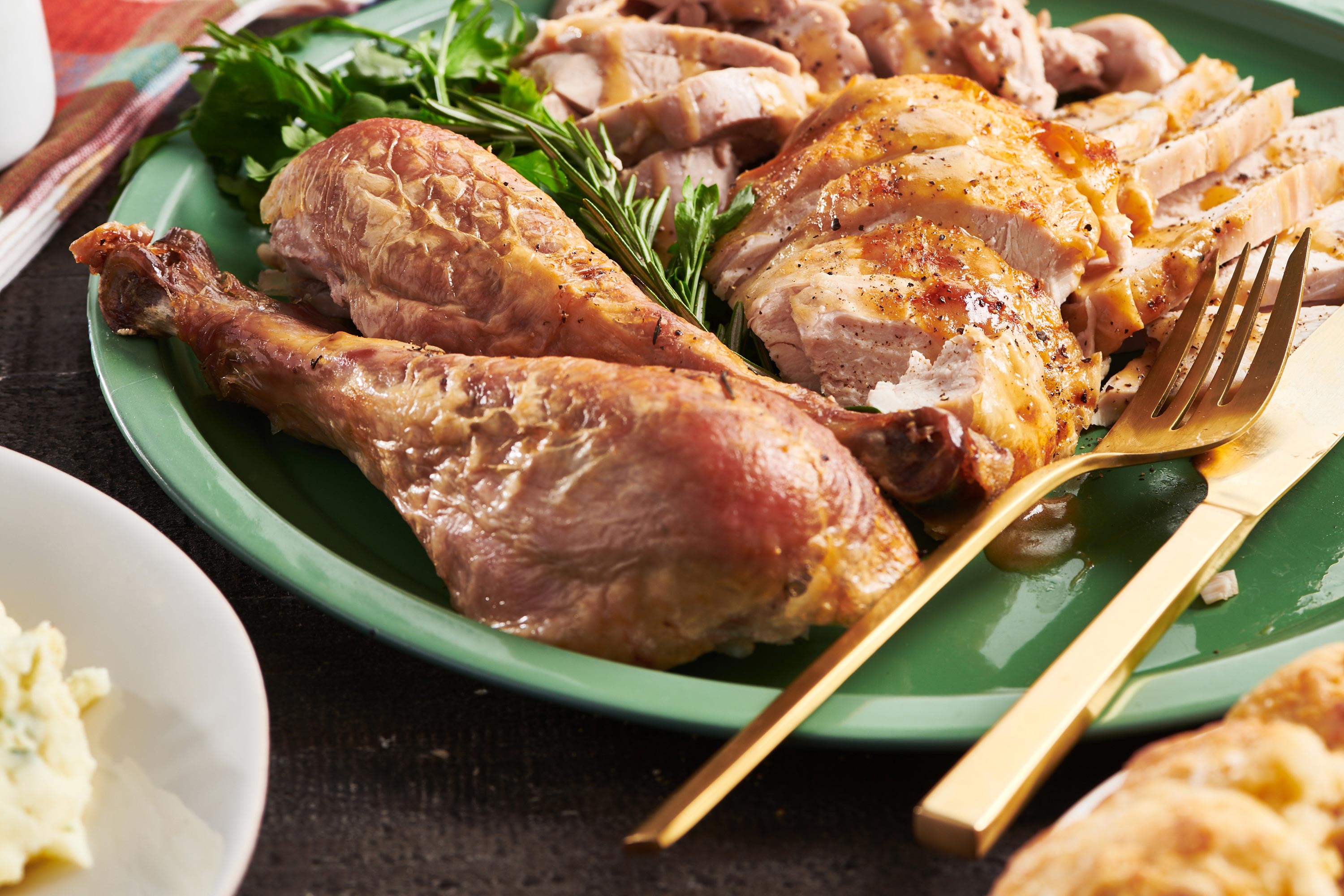
Tips for Safely Cooking a Turkey
- If your turkey is still partially frozen, it will take longer to cook and possibly cook unevenly.
- A stuffed turkey takes longer to cook. It is possible to cook a stuffed turkey safely, but more difficult, as by the time the stuffing is cooked to a safe temperature, the meat of the bird might be overcooked. It is also more likely that you might have bacteria that are not killed when cooking a stuffed turkey.
- Check to make sure that your oven does not have hot spots, which may cause the bird to cook unevenly.
- Your oven temperature might run hotter or cooler than what it is set for — use a thermometer to check that your oven temperature is accurate.
- If you use a dark roasting pan, your turkey may cook a bit faster.
- Be aware that the depth and size of the pan can affect the heat circulation to all parts of the turkey.
- If you cover the bird with foil or a roasting pan lid, it can affect the cooking time.
- An oven cooking bag can speed up the cooking time.
- The position of the rack in the oven can affect the cooking time.
- A turkey or a roasting pan that is proportionately too large for the oven may slow the cooking time.
Leftover Roast Turkey
If you have a small group for Thanksgiving but still go for a whole turkey, you might be overwhelmed by leftovers. Yes, you can freeze your leftover turkey! Whether you choose to freeze it or keep it in the fridge, there are so many possibilities for what to do with leftover turkey.
First, know that anything you can make with cooked chicken, you can make with cooked turkey. This means soups, stews, casseroles, quesadillas, burritos, enchiladas, pot pies, and so on.
And let’s not underestimate the blissful pleasure of a day-after-Thanksgiving turkey sandwich. Maybe with lettuce, tomatoes, Swiss cheese, and mustard. Maybe with some of the leftover cranberry sauce spread over the slices of turkey. Maybe grilled up with some cheddar in a skillet on a panini press.

What to Serve With Thanksgiving Turkey
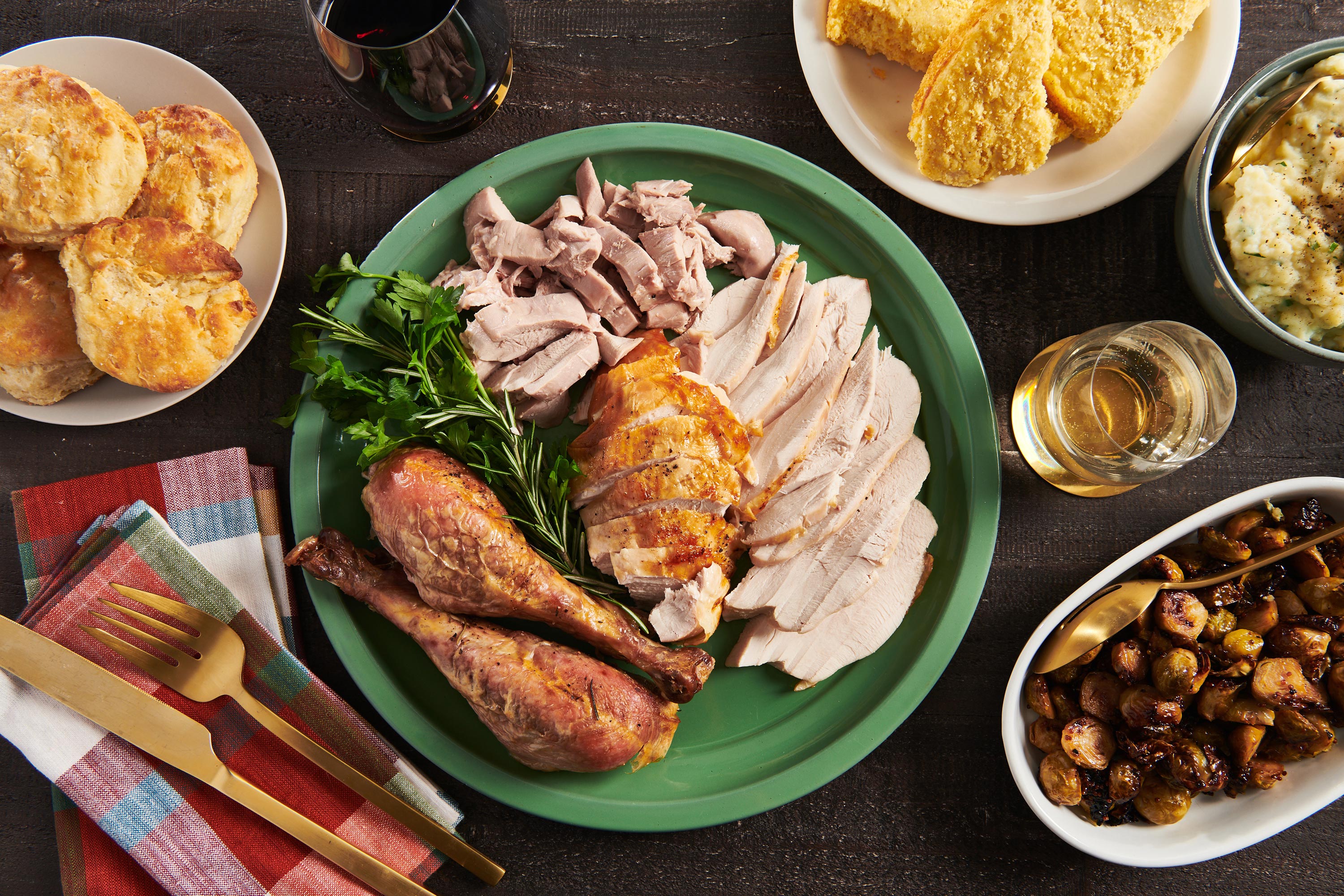
More Thanksgiving Turkey Recipes
- Cajun Roasted Turkey
- Instant Pot Turkey Breast
- Simple Slow Cooker Turkey Breast
- Grilled Split Turkey Breast
- Make-Ahead Turkey Gravy
Pin this now to find it later
Pin It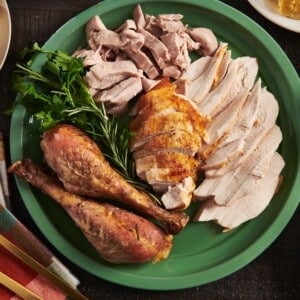
Easy Roasted Thanksgiving Turkey
Ingredients
- 1 12-pound turkey (preferably fresh; defrosted if frozen, giblets and neck reserved if available)
- 6 tablespoons unsalted butter (softened, divided)
- 3 tablespoons kosher salt
- 1 orange halved
- 2 medium yellow onions (peeled and halved)
- 4 sprigs fresh rosemary
- 8 sprigs fresh thyme
- ½ teaspoon freshly ground black pepper (plus more to taste)
- 1 cup white wine (optional)
- 1 cup chicken broth
Instructions
- Pat the turkey dry with paper towels. Rub 3 tablespoons of the butter all over the bird, legs, thighs, breasts, everywhere. Rub the salt over the bird evenly. Place the turkey into a large plastic bag, preferably a sealable one, press out the air, and seal it tight. Place the turkey in a roasting pan, breast side up in the refrigerator for 2 to 3 days. Turn the turkey at least once a day, and rub the salt into the bird through the plastic bag.
- After 2 to 3 days, and 1 day before Thanksgiving, remove the bird from the fridge and take it out of the plastic bag. Do not rinse the bird, but pat it dry with paper towels. Place the turkey on a rack in the roasting pan, and refrigerate uncovered for another 24 hours.
- Remove the turkey from the fridge 1 hour before cooking to allow it to come to room temperature. Preheat the oven to 325 F. Place a rack in the lower third of the oven, and make sure you raise or remove the upper racks so the turkey can fit with room to spare on top.
- Place the orange sections, onion halves, and rosemary and thyme sprigs into the cavity of the bird. Tuck the wings behind the back of the bird and place it in a rack in a roasting pan breast side up. Tie the legs closed (some birds have a little plastic gadget that holds the legs together, thus closing up the cavity).
- Rub the remaining 3 tablespoons of softened butter all over the turkey, covering all of the skin. Season generously with the pepper. Make sure the turkey is breast side up in the rack in the roasting pan, and place the pan into the oven.
- Pour the wine and chicken broth into the pan around the turkey. Place the pan in the oven. After 1 hour, baste the bird with the juices from the bottom of the pan. Start checking after 2 hours with an internal thermometer, sticking it into the deepest part of the thigh and making sure that it does not touch bone. The temperature should be 160 F. If, as the turkey is cooking, the top starts to get too browned, just tent a large piece of tin foil over the top of the bird.
- When the turkey is finished cooking, remove it to a cutting board with a moat, tipping any juices that have accumulated in the turkey back into the roasting pan. Let the turkey sit, tented with foil, for at least 20 minutes.
- While the turkey is resting, pour all of the liquid from the roasting pan into a large measuring cup. Put it into the fridge, and when the fat has risen to the top, use a spoon to scrape off the fat and discard. You also can use a fat separator for this purpose. Use the juice to make turkey gravy, or just drizzle the pan juices over the turkey meat.
- Carve the turkey and serve.
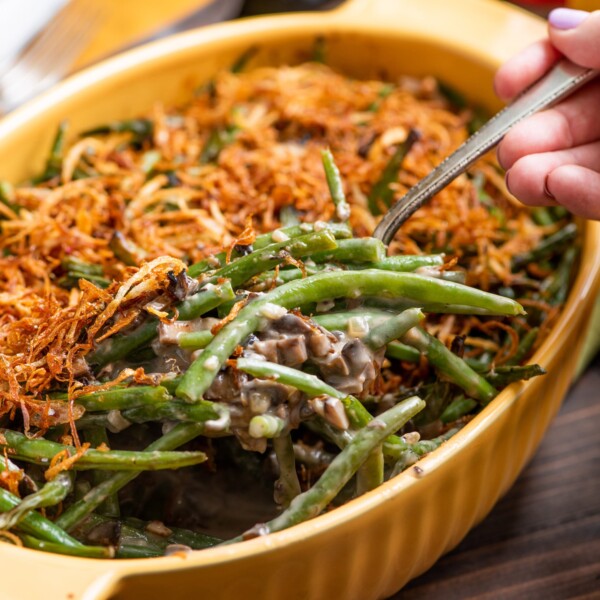
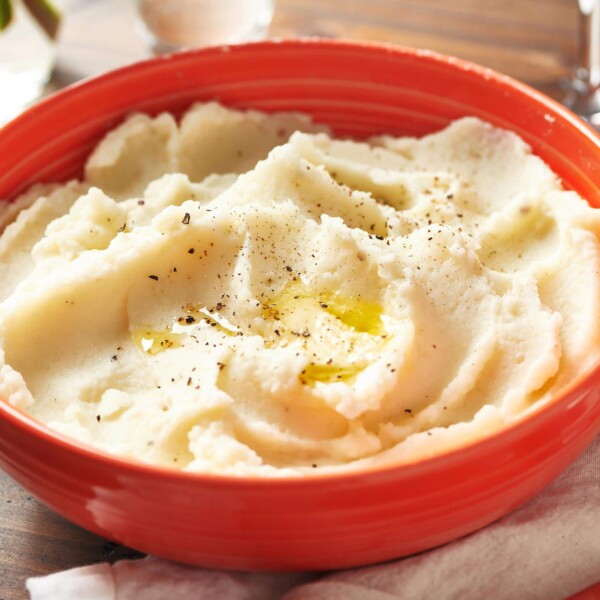
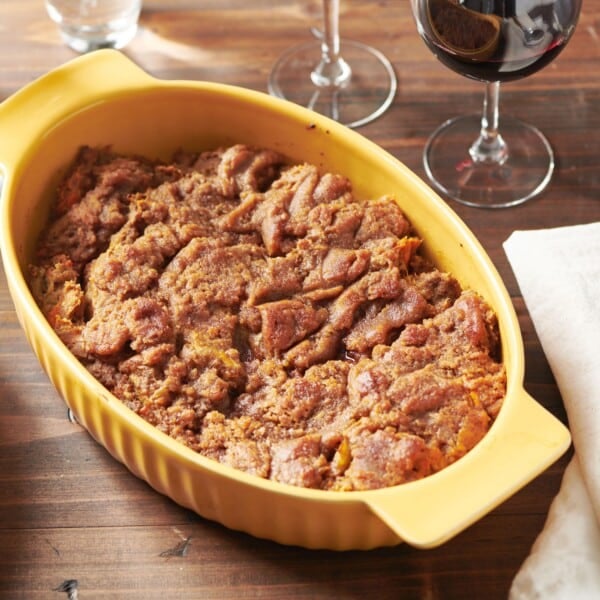
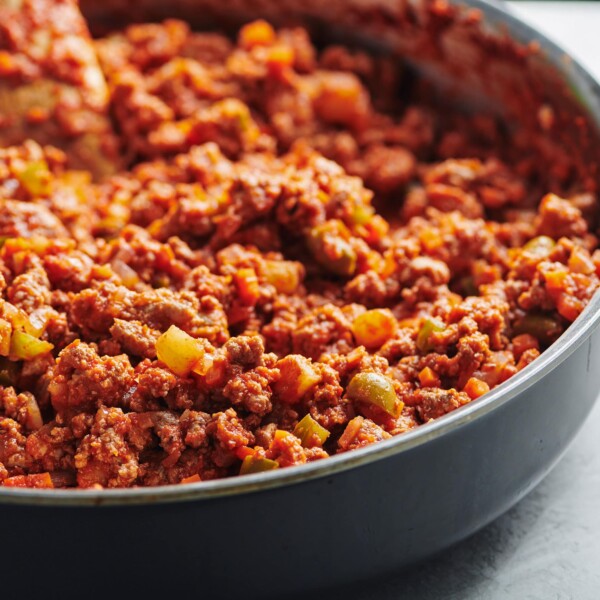
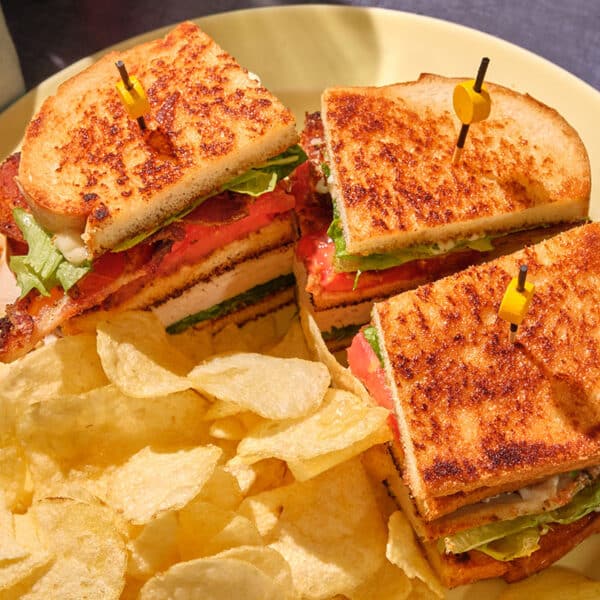
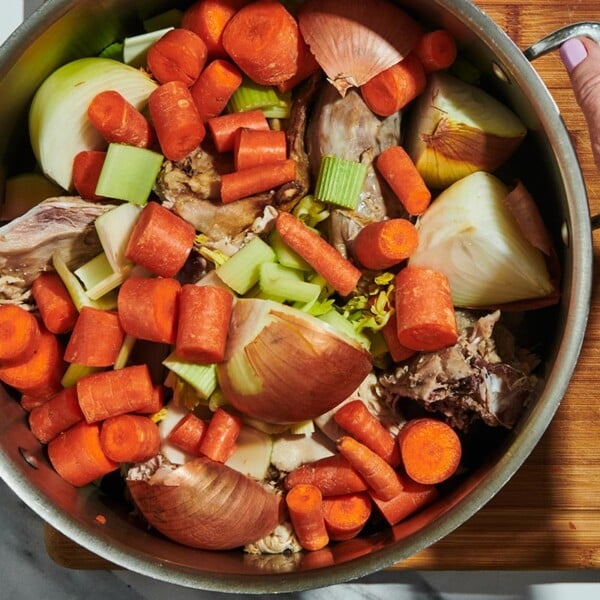










Katie-is it necessary to use a rack to make the turkey higher. I don’t have one so will have to run and get this. I also don’t have a cutting board with a moat but can search for this as well.
don’t run and get the roasting rack! just slice up an extra onion and place the turkey on the onions slices. your pan juices or gravy will be great. lifting the bird from the pan makes sure the bottom isn’t soggy (but no matter), and let’s air circulate around the bird, but it will cook just fine without it. As for the cutting board with a moat, that’s just to make sure you don’t have pan juices running all over your counter. just put the bird on a cooling rack within a rimmed baking pan to catch the juices and you will be all set.